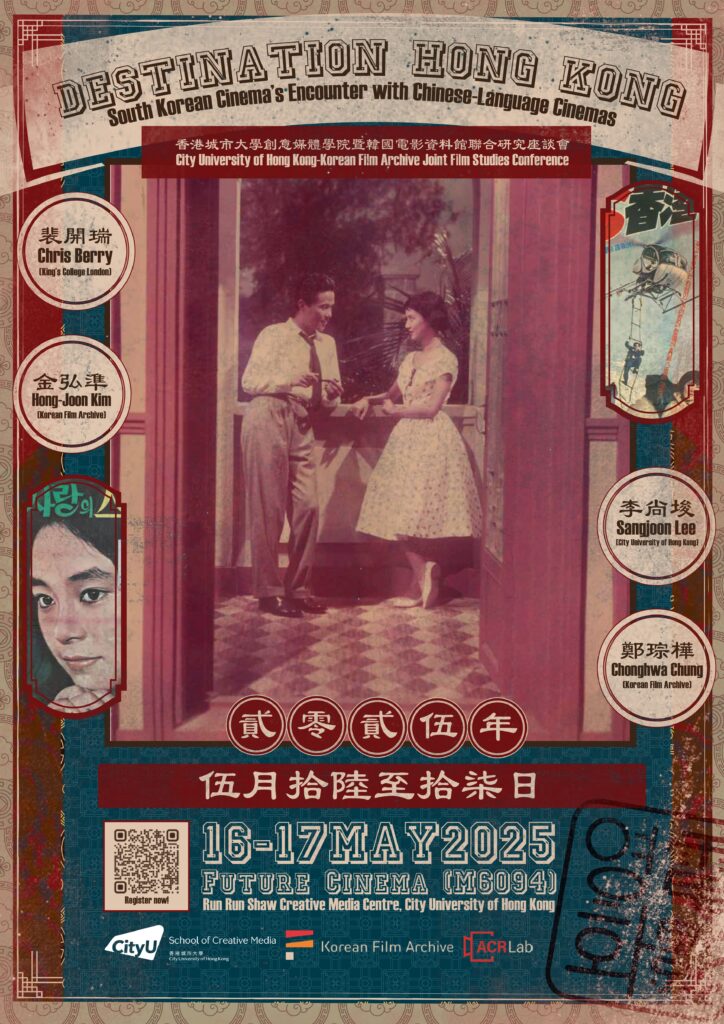NEWS
Date: 16-17 May 2025 (Fri-Sat)
Venue: Future Cinema Studio (M6094), Run Run Shaw Creative Media Centre, City University of Hong Kong
Convenors:
Sangjoon Lee (City University of Hong Kong)
Chonghwa Chung (Korean Film Archive)
Keynote Speakers:
Chris Berry (King’s College London)
Please register for the conference here: https://forms.gle/ZG2reLNTdmDW6XgH8
Conference schedule: https://shorturl.at/wUBU4
“Destination Hong Kong: South Korean Cinema’s Encounter with Chinese-Language Cinemas” conference is organized by the School of Creative Media at the City University of Hong Kong in partnership with Korean Film Archive (KOFA) and Asian Cinema Research Lab (ACR Lab). This conference will explore how South Korean cinema was shaped by a trans-regional network that included the cinemas of Hong Kong, Taiwan, Singapore, and mainland China from the 1950s to the twenty-first century. The two-day conference will bring together leading and emerging scholars and experts of South Korean and Asian cinemas from the Asia-Pacific, Europe, and North America, to present their research findings and new developments in theory and methodology.
The first contact between the film industries of South Korea and Chinese-language cinemas took place in 1957, when Love with an Alien, the first South Korea-Hong Kong coproduction, was produced and released in Hong Kong, Singapore, and Malaya through Shaw Brothers’ distribution network in Southeast Asia. Then Shin Sang-ok, the King of South Korean cinema in the 1960s, opened a new and more rigorous chapter of cinematic co-production between South Korea and Chinese- Language cinema. Consequently, from 1964 to 1967, a significant number of joint productions – such as Last Woman of Shang (1964), The Goddess of Mercy (1966), and The International Secret Agents (1966) – were completed and distributed in both film markets respectively. In the early 1970s, Shaw Brothers’ kung fu film Five Fingers of Death (1972) penetrated the American market in 1973 and became one of the most profitable films of that year. Five Fingers of Death was a Hong Kong production, but it was completed under the direction of a veteran South Korean director Chŏng Ch’ang-hwa (Cheng Chang-ho). Along with Chŏng, several prominent Korean film directors and producers collaborated with small and medium-size productions in Hong Kong, Taiwan, Thailand, the Philippines, and Indonesia.
Beginning in the 1980s, the status of Hong Kong cinema in South Korea changed rapidly. The massive commercial success of Chelsia My Love in 1977 and the record-breaking sensation of Jackie Chan’s Drunken Master (1978) brought what had been considered to be ‘working-class men’s culture to the realm of ‘everyone’s popular culture.’ Then the gangster films, which local critics labeled as ‘Hong Kong noir,’ emerged in the latter half of the 1980s. Throughout the decade, Hong Kong cinema was the most popular foreign cinema in South Korea and even threatened the status of Hollywood in the local market. After the monumental success of Tsui Hark’s Swordsman 2 (1992), however, Hong Kong cinema gradually lost its popularity. Then, beginning in the early 2000s, South Korean cinema actively collaborated with the Chinese film industry until this practice suddenly stopped in 2016 due to the diplomatic tensions between the US, China, Japan, and South Korea. As the region has experienced increasingly volatile politics and unstable economic conditions, it is difficult to predict the future trajectory of the South Korean film industry in the East Asia territory. Thus, the entangled future of South Korean cinema with Chinese-language cinema holds great potential for further discussion and research.

